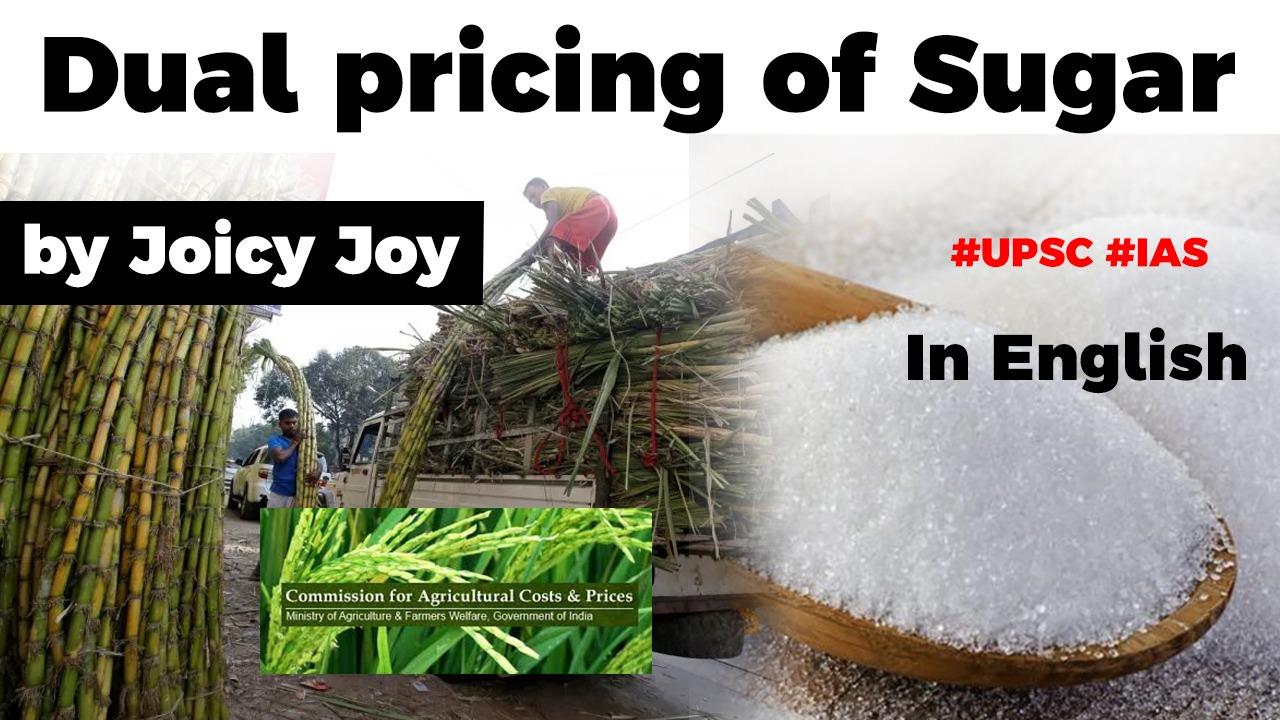Table of Contents
CURRENT AFFAIR
- The Commission for Agricultural Costs and Prices (CACP) has suggested for introducing dual pricing of sugar for commercial and domestic consumers.
STATUS
- Exports have turned feasible, because of the government subsidy and a spike in international prices.
- Realisations from domestic sales of sugar and its by-products, notably ethanol, have also improved.
- The burdensome inventories have shrunk with many mills having already got rid of their surplus stocks.
- The government has offered a series of bailout measures and fiscal sops.
- These include lucrative prices for ethanol; creation of sugar buffer stock; and soft loans to the industry with a hefty 7% interest subvention.
SUGAR INDUSTRY’S LOCATION IN INDIA
- Sugar industry is broadly distributed over two major areas of production- Uttar Pradesh, Bihar, Haryana and Punjab in the north and Maharashtra, Karnataka, Tamil Nadu and Andhra Pradesh in the south.
- South India has tropical climate which is suitable for higher sucrose content giving higher yield per unit area as compared to north India.
SIGNIFICANCE
- Multiple linkages: Sugar is a labour-intensive industry, up the entire value-chain from cane-growing to sugar and alcohol production.
- Source of employment: A sugar industry is source of livelihood for 50 million farmers and their families.
- It provides direct employment to over 5 lakh skilled laborers but also to semi-skilled laborers in sugar mills and allied industries across the nation.
- Byproducts: The various byproducts of sugar industry also contribute to the economic growth and promote a number of allied industries.
- Sugarcane has emerged as a multi-product crop used as a basic raw material for the production of sugar, ethanol, paper, electricity and besides a cogeneration of ancillary product.
- For livestock feeding: Molasses from sugar cane is used for alcohol production and livestock feeding since it is highly nutritious.
- Biofuel: In India, the vast majority of ethanol is produced from sugarcane molasses, a by-product of sugar.
- Ethanol blended fuel can help in reducing crude oil imports.
WORRYING ISSUES
- The unpaid dues to the farmers.
- Cyclic ups and downs.
NATIONAL POLICY ON BIO-FUELS 2018
- The government has allowed the use of B grade molasses and sugarcane juice as feed stocks to increase availability of ethanol.
- This recent policy modification is set to encourage the cultivation of sugarcane, a water-guzzling crop, exclusively for alcohol making.
- India, a water-stressed country can ill-afford this.
- The ecological damage from increased cane farming may be higher than the benefits of using ethanol as transport fuel.
WHAT COULD BE DONE?
- The 2012 Rangarajan committee report on sugar can be implemented.
- The practical pricing system mooted by the committee should be implemented.
BENEFIT SHARING FORMULA
- The proposed benefit sharing formula envisages assigning 70% of the revenue earned by sugar mills from the sale of sugar and its by-products to the cane growers.
- The objective is to link the prices of sugarcane with those of sugar and its byproducts.
- This would, in turn, allow the output of both sugarcane and sugar to be determined by market dynamics and stave off scarcities and gluts.
- It would also safeguard the interests of all stakeholders – cane farmers, sugar industry, traders and consumers.
OTHER RECOMMENDATIONS
- Abolition of the quantitative controls on export and import of sugar, these should be replaced by appropriate tariffs.
- Committee recommended no more outright bans on sugar exports.
- The central government has prescribed a minimum radial distance of 15 km between any two sugar mills, this criterion often causes virtual monopoly over a large area can give the mills power over farmers.
- The Committee recommended that the distance norm be reviewed.
- There should be no restrictions on sale of by-products and prices should be market determined.
- States should also undertake policy reform to allow mills to harness power generated from bagasse.
- Remove the regulations on release of nonlevy sugar.
- Removal of these controls will improve the financial health of the sugar mills.
- This, in turn, will lead to timely payments to farmers and a reduction in cane arrears.
FAIR AND RENUMERATIVE PRICE
- FRP is the minimum price that the sugar mills have to pay to farmers.
- It is determined on basis of recommendations of Commission for Agricultural Costs and Prices (CACP) and after consultation with State Governments and other stake-holders.
Latest Burning Issues | Free PDF






















 WhatsApp
WhatsApp